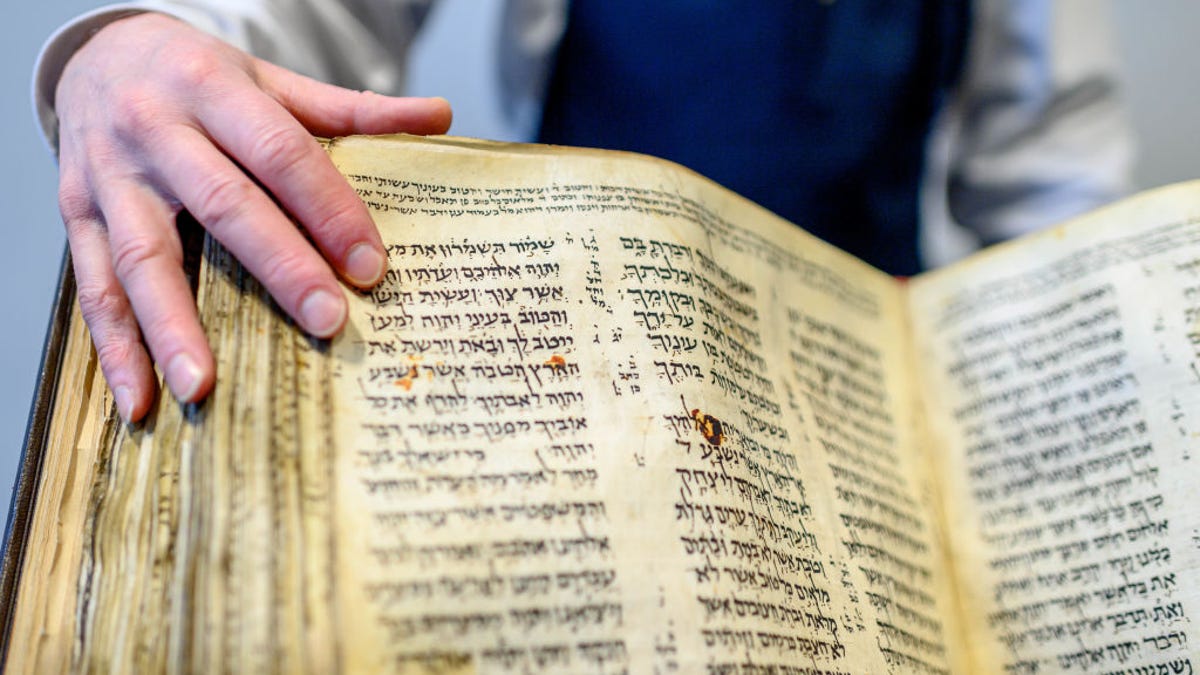Oldest Hebrew Bible Could Be Most Expensive Historical Document Ever Auctioned
The Codex Sassoon, which dates back more than a thousand years, could break records when it hits the auction block in May.
Don't let the bare hand on the Codex Sassoon worry you. Today's conservators say it's better to touch manuscripts with super clean hands than with gloves, according to Sharon Liberman Mintz of Sotheby's. "Gloves reduce the ability to turn the pages and one can harm the manuscript in attempting to turn pages without being able to actually feel the page," she says.
A Hebrew Bible considered to be the earliest nearly complete version of the pivotal book could end up being the most expensive historical document ever to land on the auction block, according to Sotheby's.
That bible, known as the Codex Sassoon, dates back more than a thousand years but is in remarkable shape for its age and missing only 12 leaves. Sotheby's will auction off the 400-page manuscript for between $30 million and $50 million on May 16, after it's been displayed in a number of major cities following decades away from the public eye.
"Codex Sassoon has long held a revered and fabled place in the pantheon of surviving historic documents and is undeniably one of the most important and singular texts in human history," Richard Austin, Sotheby's global head of books and manuscripts, said in a statement Wednesday. "With such eminence, the codex has an incomparable presence and gravitas that can only be borne from more than one thousand years of history."
Before codices such as Sassoon, ancient Hebrew biblical texts existed only in scroll form such as the storied Dead Sea Scrolls. Those fragmented documents dating back around 2,000 years lacked chapters or verses and didn't have punctuation to guide readers on how to pronounce, chant and understand the sacred words they contained.
Scholarly notes appear in the margins of the Codex Sassoon.
The Codex Sassoon, on the other hand, contains all 24 books of the Hebrew Bible in one place, organized into three parts -- the Pentateuch, the Prophets and the Writings -- and complete with accent marks that function as musical notes and vowels that appear as points under Hebrew letters to guide how the words should be pronounced and understood.
The parchment pages also display annotations and inscriptions from across centuries in margins, between columns and along the tops of pages. These notes include commentary, by early Jewish biblical scholars known as Masoretes, on the way words should be written and recited.
"Their work enabled the creation of an accurate and authoritative text of the Hebrew Bible that is used across the globe still today," Sharon Liberman Mintz, a senior Judaica specialist in Sotheby's books and manuscripts department, told me.
Other inscriptions in the Codex Sassoon bring its history and travels to vivid life.
One entry dating back to the early 11th century, for example, references a sale by a businessman named Khalaf ben Abraham to Isaac ben Ezekiel al-Attar. Al-Attar later transferred ownership to his sons, Ezekiel and Maimon.
Another inscription tells us the Codex Sassoon belonged to a synagogue in Syria, likely in the 13th century. Still another informs us the town where that synagogue was located got destroyed around the year 1400 and the Codex was entrusted to a community member named Salama bin Abi al-Fakhr who was instructed to return it when the house of worship was rebuilt. It never was.
The ancient manuscript is named for one of its owners, David Solomon Sassoon, a prolific and celebrated British collector of Judaica and Hebraic manuscripts who died in 1942. He acquired the codex in 1929 and attached his bookplate to the inside cover, where it remains.
Sassoon's heirs sold the codex to the British Rail Pension Fund in 1978 through Sotheby's Zurich, and current owner Jacob Safra, heir to a Syrian Lebanese-Swiss banking family, acquired it in 1989. Safra recently had it carbon-dated and discovered it's a century older than the earliest entirely complete Hebrew Bible, known as the Codex Leningrad.
Before Sotheby's auctions off the Codex Sassoon, it'll go on a global tour, first stopping at Sotheby's in London from Feb. 22-28, and then going on to Tel Aviv, Dallas, Los Angeles and New York City.
The codex may be 1,100 years old, but it's far more than just ancient animal skin, says Rabbi Mordechai Lightstone, founder of Tech Tribe, a community for Jews in tech and digital media.
"The Codex Sassoon is exciting," he said, "because it represents a link in the chain of Jewish tradition, connecting ancient writing from Sinai (where the Ten Commandments were given to Moses by God, according to the Hebrew Bible) to the very texts studied today on our digital devices."


